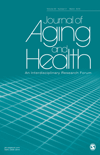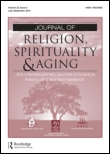
Anthropology & Aging
Scope & Guideline
Bridging Disciplines to Understand Aging
Introduction
Aims and Scopes
- Cultural Perspectives on Aging:
The journal emphasizes the importance of understanding aging through various cultural lenses, exploring how different societies conceptualize and manage the aging process. - Interdisciplinary Approaches to Elder Care:
It encourages interdisciplinary research that integrates anthropology with fields such as sociology, psychology, and gerontology to provide a holistic view of elder care. - Impact of Technology on Aging:
The exploration of how technological advancements affect the lives of older adults is a core area, addressing both the benefits and challenges posed by new technologies in care settings. - Migration and Aging:
The journal investigates the experiences of aging in the context of migration, focusing on how older migrants navigate their identities and care needs in new environments. - Social Justice and Aging:
A strong emphasis is placed on issues of inequality, access to care, and the rights of older adults, advocating for social justice and policy change to improve elder care.
Trending and Emerging
- Care Technologies and Innovations:
There is a growing interest in how care technologies, including robotics and digital health tools, are transforming elder care practices and the implications for older adults' wellbeing. - Intersectionality in Aging Research:
An increasing focus on intersectionality highlights how age, gender, ethnicity, and socio-economic status intersect to shape the experiences of aging, leading to more comprehensive studies. - Community and Belonging:
Research that explores themes of community, belonging, and social networks among older adults is on the rise, emphasizing the importance of social ties for mental and emotional health. - Global Perspectives on Aging:
The journal is expanding its scope to include more global perspectives, particularly from non-Western contexts, which enriches the understanding of aging as a universal yet culturally specific experience. - Narratives and Storytelling in Aging:
There is an emerging trend in utilizing narrative and storytelling as methodologies to capture the lived experiences of older adults, allowing for deeper insights into their identities and challenges.
Declining or Waning
- Traditional Models of Aging:
Research focused solely on traditional, biomedical models of aging is becoming less frequent, as the journal increasingly prioritizes holistic and cultural perspectives. - Generational Studies Without Contextualization:
Studies that examine aging strictly through generational lines, without considering cultural and social contexts, are waning in favor of more nuanced, intersectional analyses. - Aging in Isolation:
There has been a noticeable decrease in research that examines aging in isolation from family or community dynamics, as the journal shifts towards exploring interconnectedness and social networks. - Homogeneous Aging Experiences:
The portrayal of aging as a uniform experience across different demographics is less common, with more emphasis placed on diversity and the unique challenges faced by various groups. - Focus on Economic Aspects of Aging:
While economic factors are still relevant, there is a decline in articles that solely address financial issues related to aging, as the journal expands to include broader socio-cultural discussions.
Similar Journals

JOURNAL OF AGING AND HEALTH
Elevating discourse on aging and societal health.The JOURNAL OF AGING AND HEALTH, published by SAGE PUBLICATIONS INC, is a preeminent peer-reviewed journal dedicated to advancing research in the field of gerontology and related disciplines. With an impressive impact factor and ranked Q1 across multiple categories including Community and Home Care, Geriatrics and Gerontology, and Health (Social Science), this journal has established itself as a vital resource for academics, clinicians, and policymakers alike. Spanning over three decades of publication from 1989 to 2024, it serves as a platform for innovative research and multifaceted discussions on aging, health, and the interplay of social factors influencing the elderly population. The journal's rigorous standards for publication ensure high-quality contributions that are impactful and relevant, making it an essential read for those dedicated to improving the health and quality of life for older adults. Although it is not an open-access journal, it provides comprehensive insights that are critical to understanding the complexities of aging in today's society.

Journal of Religion Spirituality & Aging
Exploring the Intersection of Faith and AgingThe Journal of Religion, Spirituality & Aging, published by Routledge Journals, Taylor & Francis Ltd, is a vital interdisciplinary platform that explores the intricate relationships between spirituality, religion, and the aging process. With an ISSN of 1552-8030 and an E-ISSN of 1552-8049, this journal critically addresses the evolving challenges and opportunities faced by older adults in the context of faith and spirituality. Covering a wide range of topics and methodologies, it has garnered a strong reputation in its field, achieving a Q1 ranking in Religious Studies and a Q3 ranking in Life-span and Life-course Studies for 2023. The journal serves as an essential resource for researchers, professionals, and students interested in gerontology, psychology, sociology, and related fields, fostering a deeper understanding of how spirituality can enhance the quality of life among older populations. While not an open-access journal, it continues to contribute significantly to the discourse on aging and spirituality through carefully curated scholarly articles, reviews, and studies.

JOURNAL OF AGING STUDIES
Illuminating the Pathways of AgingJOURNAL OF AGING STUDIES is a leading publication dedicated to the interdisciplinary exploration of aging, providing a platform for researchers, professionals, and students interested in the complex dynamics of aging in contemporary society. Published by Elsevier Science Inc, this esteemed journal has established itself as a key resource in various categories, achieving a Q1 ranking in Issues, Ethics and Legal Aspects and a Q2 ranking in multiple health-related disciplines as of 2023. The journal focuses on a broad range of topics, including health policy, social sciences, and life-span studies, contributing significantly to discussions surrounding aging through its rigorous peer-reviewed articles and comprehensive research studies since its inception in 1987. With an ISSN of 0890-4065 and an E-ISSN of 1879-193X, it serves as an essential reference for academic and professional audiences, and remains committed to advancing knowledge and policy in the field of aging.

Generations
Exploring the Complexities of Aging TogetherGenerations, published by the American Society on Aging, serves as a vital interdisciplinary platform for scholars and practitioners within the field of aging and gerontology. With its ISSN of 0738-7806 and E-ISSN of 2694-5126, this journal has been a valuable resource since its inception in 1985, connecting research and practice across converging years and advancing discussions surrounding the complexities of aging and lifespan studies. Although classified in the Q4 quartile for categories such as Geriatrics and Gerontology, Life-span and Life-course Studies, and Public Health, its contributions are increasingly relevant in a rapidly aging society. The journal’s emphasis on critical issues surrounding aging makes it essential reading for health professionals, policy makers, and researchers dedicated to enhancing the quality of life for older adults. As it continues its publication journey up to 2024, Generations remains committed to fostering scholarly discourse and offering innovative insights in this crucial area of study.

Innovation in Aging
Leading the way in interdisciplinary aging studies.Innovation in Aging, published by Oxford University Press, is a prestigious open-access journal dedicated to advancing the understanding of aging and its implications on health and society. Established in 2017, the journal has rapidly gained a strong reputation within the academic community, achieving Q1 rankings in multiple categories including Health Professions, Health (Social Science), and Life-span and Life-course Studies, with impressive Scopus rankings that place it among the top journals in its field. With an emphasis on innovative research and interdisciplinary approaches, Innovation in Aging aims to foster dialogue among researchers, professionals, and policymakers, addressing key challenges and breakthroughs in gerontology, geriatrics, and related disciplines. As an open-access journal, it provides accessible content to a wide audience, supporting knowledge dissemination and collaboration to improve the quality of life for aging populations. This journal is essential for those looking to stay at the forefront of aging research and its impact on health and society.

Nature Aging
Leading the Charge in Aging Research ExcellenceNature Aging, published by SPRINGERNATURE in Germany, stands as a premier journal dedicated to advancing the field of aging research. With high-ranking performance indicators, including a Q1 classification in Aging, Geriatrics and Gerontology, and Neuroscience (miscellaneous), this journal emphasizes the interdisciplinary nature of aging studies. Its Scopus rankings highlight its impact, achieving remarkable positions such as #1 in Neuroscience and #2 in both Geriatrics and Biochemistry for aging-related research. Although currently not open access, Nature Aging provides a wealth of cutting-edge research and critical reviews that aid researchers and practitioners in understanding the complexities of aging mechanisms and their implications. As the field continues to evolve from 2021 through 2024, this journal not only facilitates the dissemination of knowledge but also fosters innovative discussions that propel the science of aging forward. Join the vibrant community of scholars and professionals dedicated to solving the challenges associated with aging by engaging with the content published in Nature Aging.

BIOGERONTOLOGY
Pioneering Research on the Biology of AgingBIOGERONTOLOGY, published by SPRINGER, is a premier journal dedicated to the interdisciplinary study of biological aging processes and their implications for health and longevity. With an ISSN of 1389-5729 and an E-ISSN of 1573-6768, this journal features cutting-edge research that addresses critical questions in the fields of aging, geriatrics, and gerontology. Ranking impressively in the top quartiles, particularly as Q1 in Gerontology, BIOGERONTOLOGY is recognized for its contributions to advancing the understanding of aging at both molecular and systemic levels. The journal’s rich repository of scholarly articles provides valuable insights for researchers, healthcare professionals, and students alike, fostering a deeper comprehension of age-related biological mechanisms. Although not an open-access journal, it is highly regarded with an impact factor that reflects its significant role in the academic community. The journal spans from 2000 to 2024, ensuring a broad historical context for its studies, and is based in the Netherlands, with its administrative office located at One New York Plaza, Suite 4600, New York, NY 10004, United States. Engaging with BIOGERONTOLOGY means joining a global dialogue on the science of aging and the implications it holds for humanity.

EDUCATIONAL GERONTOLOGY
Pioneering research for a wiser, more educated aging population.EDUCATIONAL GERONTOLOGY, published by Taylor & Francis Inc, is a leading academic journal dedicated to the study of education and aging. With an ISSN of 0360-1277 and an E-ISSN of 1521-0472, this journal has been an essential resource since its inception in 1976, continuing to provide invaluable insights until 2024. As an authoritative platform in the fields of Education and Gerontology, it ranks in the Q2 category for Education and Q3 in Geriatrics and Gerontology, reflecting its significant contribution to these domains. The journal is well-regarded for its rigorous peer-reviewed articles that explore innovative educational practices for older adults and address the challenges faced by this demographic. Researchers, professionals, and students alike can benefit from the multidisciplinary approaches and comprehensive research findings presented within its pages, making it a vital tool for advancing knowledge and practice in educational gerontology.

REJUVENATION RESEARCH
Pioneering Research for a Healthier TomorrowRejuvenation Research is a premier journal dedicated to the advancing field of gerontology and aging research, published by Mary Ann Liebert, Inc. Established in 2000, the journal serves as a pivotal platform for the dissemination of scholarly articles that explore the complex mechanisms of aging and innovative approaches to rejuvenation. With an impact factor reflective of its robust scholarly contributions, the journal currently holds a Q4 ranking in Aging and a Q3 ranking in Geriatrics and Gerontology, showcasing its relevance in the academic community. This periodic publication, welcoming open access submissions, invites researchers, professionals, and students alike to engage with cutting-edge findings that could shape future geriatric practices and enhance quality of life. The journal underscores the importance of interdisciplinary collaboration, encouraging explorations that intersect with biochemistry, genetics, and other vital areas of study. Through its ongoing commitment to high-quality research, Rejuvenation Research remains a critical resource for understanding the biological underpinnings of aging and the strategies to mitigate its effects.

ARCHIVES OF GERONTOLOGY AND GERIATRICS
Innovating insights into the biology and psychology of aging.The Archives of Gerontology and Geriatrics, published by Elsevier Ireland Ltd, is a leading journal in the fields of Aging and Geriatrics and Gerontology. With an ISSN of 0167-4943 and an E-ISSN of 1872-6976, it has established itself as a crucial platform for disseminating high-quality research focused on the biological and psychosocial aspects of aging. The journal holds an impressive Q2 ranking in both Aging and Geriatrics and Gerontology, and a Q1 ranking in Gerontology and Health (Social Science) as of 2023, reflecting its significant impact in these disciplines. Additionally, the journal is ranked #33/371 in Social Sciences (Health) and #5/39 in Nursing (Gerontology) according to Scopus, showcasing its esteemed position in the academic community. Although currently not open access, the journal offers a wealth of research articles from 1982 to the upcoming 2025 that are vital for stakeholders including researchers, healthcare professionals, and students aiming to advance their understanding of aging processes and policies. Titles published within its pages contribute to shaping agendas in public health and gerontological practice, making it an essential resource for those involved in the study of the elderly population.